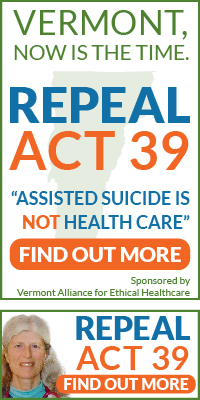Assisted suicide is becoming a pseudo-religion, a form of spirituality, in which “(Brittany) Maynard has become a sort of secular saint for the cause, and the media have provided her hagiography,” according to Psychiatrist Aaron Kheriaty of the University of California at Irvine. What is being worshipped? In a blogpost linked below, Kheriaty writes that it is a delusional idea of non-existent, impossible control, made all the more ironic by the fact that it is about death, the ultimate proof that in the end we simply do not have control.
True Dignity has repeatedly sounded an alarm as the language used by assisted suicide promoters has become increasingly and unabashedly romantic. As long as it is assisted suicide by a person thought by two doctors to be terminally ill, an act that has historically been viewed with horror and sadness and has been met with prevention efforts is now called “beautiful”, “peaceful”, “remarkable” and “awesome”, worthy of being enabled. Before 2013, we had read one romanticized obituary in an Oregon newspaper for someone who had committed assisted suicide. However, proponents gradually discovered that conjuring up pretty images of assisted suicide deaths worked__it worked with the VT legislature in 2013__, so Compassion and Choices (formerly known as The Hemlock Society) adopted that strategy in its statewide “educational” effort in Vermont during the summer of 2014, subtly morphing, there and elsewhere, the “movement” for assisted suicide, as Kheriaty says, into something greatly resembling a religion.
As we have noted again and again, the World Health Organization, the National Institutes of Mental Health, and the Vermont Suicide Prevention Platform all warn against using sensationalizing or romanticizing language in public descriptions of suicide, because of the danger of suicide contagion. Though nobody writes a suicide note blaming the act on a newspaper story or a radio report, the existence of suicide clusters has been known since antiquity.[i] In Vermont, we wonder if the use of such language, in-state and also in the nationally-distributed Brittany Maynard suicide videos, contributed to the cluster of three assisted suicides that occurred here between October 27, 2014 and January 15, 2015, after seventeen months with no deaths under the assisted suicide law.
Kheriaty says it would be far more sensible, and healthier, for people to concentrate their passions and the energies that spring from them on coming to terms and helping others come to terms with reality, the things we cannot change, especially death.
Traditionally, at least in western cultures, we have honored those who died a good death, fighting it as long as fighting was sensible, accepting death when it was obviously inevitable or when doing so would prevent a greater evil or bring good to others, but never self-inflicting it.
If our culture takes the other route, worshiping death and honoring those who bring it on themselves, imagine the trajectory on which we will have set ourselves. Saints are persons to be emulated. If our society canonizes people like Brittany Maynard and perhaps Vermont’s Maggie Lake, whose suicide death seems to have taken place at precisely the moment when it was needed to put a value on just the regulations certain pro-assisted-suicide Vermont Senators were about to introduce legislation to preserve in the law, it would be delusional not to expect others to follow their examples, especially that of Maynard, who explicitly spoke of finding meaning in the hope that her suicide would lead to enabling other suicides by expanding legalization of assistance to more states.
Suicide bombers also speak of finding meaning in their suicides. In trying to understand why they do, we analyze their motives in terms of the problems they face in societies we see as different from ours, with worse economic conditions, a greater sense of rootlessness among the young, etc. Are we sure they are so different? How many people of all ages feel rootless in our own society?
If we don’t stop ourselves short, we will soon be facing not just the vanishing of the taboo on suicide but a positive cult of suicide. How many people, searching for meaning, will find and follow this cult? How many will we lose? The Oregon experience indicates a strong possibility that there will be many. In Oregon, the first annual assisted suicide report was issued in February, 1999. Beginning in 2000 the non-assisted suicide rate, which had declined throughout the nineties, began to rise. It has not stopped rising, and the last available report, issued in 2012, showed it to be 41% above the national average.
Sadly it appears that the promoters of assisted suicide are willing to accept the sacrifice of these possible victims of suicide contagion in order to preserve and spread the movement to which they adhere with evangelistic fervor that we think Kheriaty is right to describe as religious. Certainly they have been warned in Vermont. In Australia, assisted suicide crusader Philip Nitschke has explicitly said that such casualties will occur and are an acceptable price to pay.[ii]
As Kheriaty writes, “A culture that honors and exalts those who deliberately reject life is a culture that eventually will come to worship death.” This prospect should, but no longer seems to, both sadden and alarm us. More than that, it should awaken us. It is still not too late to stop the “movement”, and there is great hope in the fact that no state has followed Vermont in legalizing assisted suicide.
http://www.firstthings.com/article/2015/04/apostolate-of-death
[i] Hecht, Jennifer Michael, Stay (New Haven, Yale University Press, 2013), p. 26.
[ii] http://www.truedignityvt.org/euthanasiaassisted-suicide-advocate-phillip-nitschke-there-will-be-casualties/

